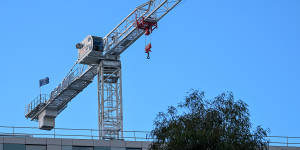Though building approval numbers are low,the total value of those approvals remains high,indicating building costs are continuing to climb,which is deterring developers of medium and high-density housing and adding to housing costs,Commonwealth Bank of Australia (CBA) economist Harry Ottley said.

Residential building approvals were at near decade-lows,CBA analysis of Australian Bureau of Statistics data found,despite a slight uptick in the March quarter.
Multi-unit residential buildings were down 23 per cent in a year,while house approvals rose 2.9 per cent.
“This explosion of building costs has been unprecedented,” Ottley said. “Normally if you see approvals come down,you would see the value come down as well.”
When developers are uncertain about building units and townhouses,it affects supply,he said,which then puts huge pressure on the rental market.

“What really drives rents and the rental market is those multi-unit dwellings,” Ottley said.
“It’s the big developers really that need to build these big apartments,and they need certainty over a period of years to ensure that their project is feasible.
“It’s important for interest rates to come down to start stimulating some of this.”
A hangover from lockdown-era materials shortages was one of the reasons building costs were high and approvals were low,but as commodities costs settled,other factors were impacting costs – among them high interest rates,Ottley said.

Falling completions indicated housing markets would continue to be hit with supply pressure.Eddie Jim
“What really is needed in the longer term to ease some of that pressure is more apartments and townhouses,and what’s required for that at the moment is for rates to come down a little bit,” he said.
“Increasing interest rates further is not going to help that part of the market – if anything,it will make it worse. Raising rates in this environment for housing is bad.”
There was also a backlog of unfinished or unstarted housing projects – mostly townhouses and apartments – that would usually be finished if it weren’t for building costs,he said.
“The uncertainty is how many of these projects have been shelved altogether or are going to come online next quarter,or are going to come online in a year or two years – that’s what we don’t know.”
Labour shortages were also a big reason for high building costs,with skilled workers having their pick of a huge backlog of residential projects as well as other builds.
“You had a big rise in non-residential construction – warehouses,factories,data centres,hospitals – so that sucks out capacity in the residential industry,” Ottley said.
“The really key one has been the public infrastructure pipeline,huge projects like we haven’t seen in a long time.”
He said builders were now “paying through the nose” to attract workers,and that they had no choice but to pass those costs onto clients.

Housing Industry Association chief economist Tim Reardon said all skilled tradespeople were in demand,from carpenters and plasterers to plumbers and electricians.
“This isn’t a marginal. This is a deep structural problem,” he said.
Reardon said the federal government had not yet added tradespeople to the priority list for migrant visas.
“There is a range of longer-term solutions,which does include the industry training more apprentices. But the industry would also like to be able to gain access to overseas skilled tradespeople,” he said.
“Any initiative to free up access to overseas labour will increase the capacity of the industry to build more homes.”
Reardon said building costs would likely not come down from their current levels,even if the cost of materials decreased and labour shortages were addressed.
“The cost of construction will continue to rise,but over the next few years,we expect it to be at a rate similar to or consistent with CPI. That’s assuming that we don’t see additional taxes or regulatory imposts imposed upon home-building.”
If building costs keep rising,housing costs in general will follow suit – unless land becomes less expensive,Reardon said.
“Whether it’s greenfield,land for a detached house or an apartment doesn’t change the dynamic,” he said. “There has been an inadequate supply,and inadequate supply is a consequence of local council planning restrictions,state government taxes and federal government restrictions on investment.”
Centralised cities also make land expensive,said Reardon,and the development of secondary and tertiary cities across Australia could help ease the demand for a patch of grass to build on.
“But there are a lot of infrastructure projects going on that have soaked up the labour,which means we don’t have enough labour to build homes. But we do need that infrastructure to create the capacity to build homes in the future,so it does become a little bit of a cyclical problem.”